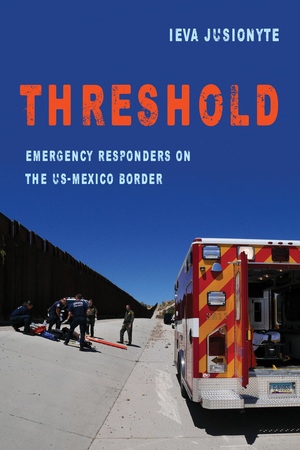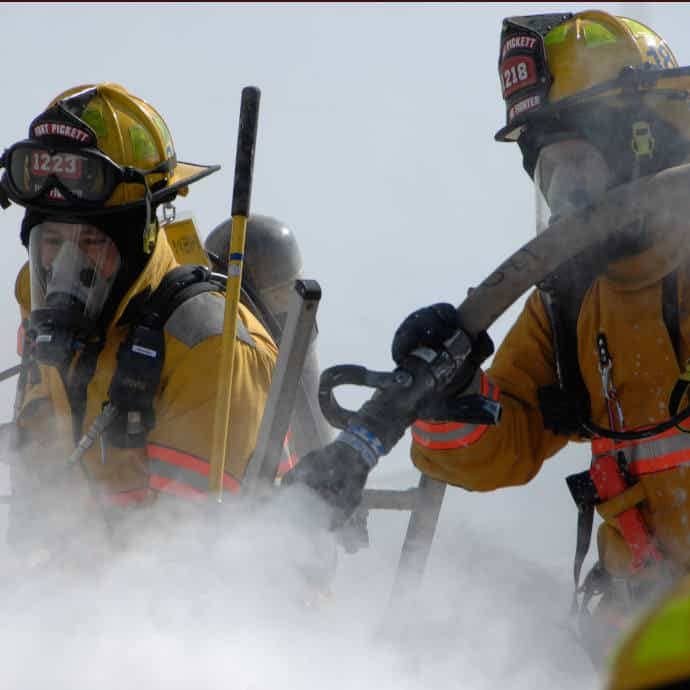A close friend, currently preparing to become a military firefighter in Brazil, described his training as an exercise in “how to become a hero.” His curriculum includes rescue exercises on land and in the water; incidents involving fires, hazardous substances, drownings, car crashes, and shootings; and the appropriate use of equipment for each case. Whatever type of event, trained firefighters should be able to assess the scene and know what “powers” and gadgets in their toolbox are necessary to complete the mission.
In Threshold: Emergency responders on the US-Mexico border, Ieva Jusionyte shows how emergency responders interpret “space through the lens of threats – both natural and manmade” (26) and how this perspective contrasts with securitized understandings of the border by the US federal government’s Border Patrol (BP), charged with detaining and deporting those it considers “illegal aliens.” Both are part of the same state but report to different authorities: BP to the US federal government and emergency responders in fire departments to local authorities.
Threshold is based on fieldwork in fire departments in Nogales, Sonora (Mexico) and Nogales, Arizona (United States) – jointly called Ambos Nogales (both Nogales) – as well as in different settings in other smaller towns. Jusionyte’s experience as a trained firefighter and emergency medical technician (EMT) adds a layer of nuance to her ethnography. Describing her experience at the fire department in Boston where she received training, at a time when she was also finishing her PhD, she notes that “[firefighters’] bodies and tools were fine-tuned with the urban environment, synced and tied to it” (219) as they anticipate emergencies based on the weather.
The book draws on various experiences as it weaves together questions of embodied expertise with the materiality of terrain and infrastructure, touching on the broader topics of the state, ethics, borders and migration.
The reader learns how emergency responders espouse “heroic sacrifice” on the one hand and “an ethics of anti-politics” on the other, by refusing to directly engage with, and often to speak of, politics.
Jusionyte then asks: “what is the threshold of politics in emergency response?” (27-28). She answers this question by describing two contrasting understandings about the materiality of terrain at the border, held by emergency responders and Border Patrol.

The federal government’s Border Patrol, in turn, holds a contrasting understanding that strategizes these same spaces to hinder migrants’ movements, intentionally shaping the terrain to wound them. High and sharp fences can deter, stop or slow crossing attempts, and serve to push migrants further into the “hostile terrain” of deserts that provide a natural barrier.
Emergency responders and Border Patrol represent the same state, yet they operate on different readings of the same space. The productive tension that Jusionyte explores is how, at its threshold, the state “both wounds and cares” (24).
In the second part of the book Jusionyte shows how aid flows asymmetrically across the border. Firefighters in Ambos Nogales, like the natural and manmade disasters they respond to, are not impeded by the physical presence of the border. Yet, when there is an emergency that overwhelms the capacity of fire departments on either side, only Mexican bomberos (firefighters) move north to help, since US responders are fewer and recently became uninsured for work accidents in Mexico. The flow of donations (equipment and materials) is also asymmetrical, flowing from US fire departments to their Mexican counterparts.
The third part of the book discusses how “borderlands fall into the gray area of the law” (184), where there is an ethical contest between Border Patrol and charities regarding what constitutes right and wrong stances towards migrants crossing the border.
Readers familiar with the anthropology of humanitarianism see parallels abound. Threshold elicits questions about the possibilities and limits for a humanitarian ethos within (or along) the boundaries of states that normally enact it abroad. In contrast to the French context, where asylum seekers draw on their sick selves to obtain refuge (Fassin and D’ Halluin 2005; Ticktin 2006), at the US-Mexican border the wounded body is seen by the state as “proof of crime” (14), which the migrant seeks to hide. Body wounds attest to illegal attempts at crossing the border and thus help characterize individuals as “illegal aliens,” targets for detention and deportation by Border Patrol.
Moreover, one learns that the work of emergency responders is similar to the work performed by “humanitarian workers.” They seek to alleviate suffering without discrimination based on nationality or ascribed legal status, while positioning themselves outside of politics. Yet, looking at the asymmetrical flow of emergency responders on the border, one can see a “politics of life” (Fassin 2007) in the hierarchy of whose lives can be put at risk and whose should be saved – Mexican lives can be put at risk to save US citizens on US soil, but not the other way around.
What the reader might find most interesting is Jusionyte’s personal relationship to emergency response and how her previous experience in that profession shaped the research.
Her first contact with the work of firefighters was during her dissertation fieldwork on local media in the tripartite border between Argentina, Brazil and Paraguay in Iguazu, where journalists routinely stopped at fire stations for news on the latest emergency. After taking shelter in a fire station during strong storms, she overcame long-held fears and found comradery in the everyday work of firefighters. Upon returning to the US, she decided to start her emergency responder training – marked by physical toll and the same comradery she found in Iguazu – along the final stages of her PhD. This then led her to conduct ethnographic research with emergency responders along Mexico-US border, a move she made partly not to risk jeopardizing friendships established in the places where she had previously volunteered.
Jusionyte cautions the reader that her account of events in Threshold may have been detached, which is the standard way emergency responders respond to and report on everyday emergencies. Her fragmented narrative, also a reflection of the nature of the job, conveys the emotional distance required from rescuers, as they move from one emergency to the next. As an example of these spatial fissures, she recounts moving from a school class’ visit to the fire department to the rescue of a woman with an open fracture on the border, and then back to the class. Avoiding the glorification of violence, and without explicitly deploying sentiments in the text, Jusionyte’s writing evokes strong emotional reactions in the reader, offering a window into pressing current issues on migration, borders and securitization. While providing important insights into the politics of border control and emergency response, this book is a timely and beautifully written contribution to public anthropology.
References
Fassin, Didier. 2007. “Humanitarianism as a Politics of Life.” Public Culture 19 (3): 499–520.
Fassin, Didier, and Estelle D’ Halluin. 2005. “The Truth from the Body: Medical Certificates as Ultimate Evidence for Asylum Seekers.” American Anthropologist 107 (4): 597,608.
Ticktin, Miriam. 2006. “Where Ethics and Politics Meet.” American Ethnologist 33 (1): 33–49.
Jusionyte, Ieva. 2018.Threshold: Emergency Responders on the US-Mexico Border. University of California Press.
Featured image by The U.S. Army (flickr, CC BY 2.0)









